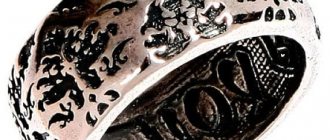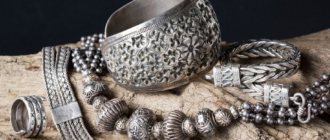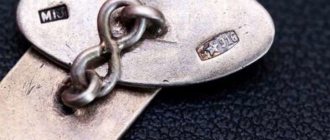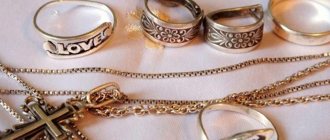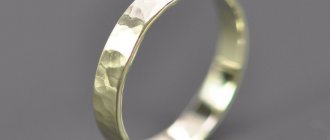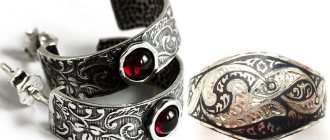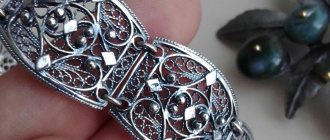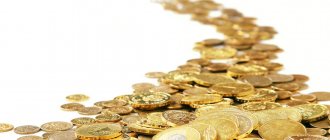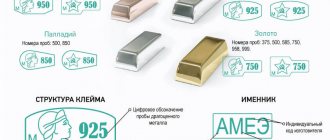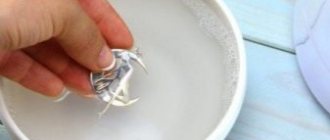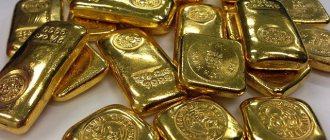Silver hallmarks are markings on a precious metal that indicate the purity of the alloy. Different countries used their own marking systems, but the masters had one goal - to show the buyer the quality of their creation. Pure silver has never been used in production - the metal is too soft and not suitable for dishes and jewelry.
Silver hallmarks often consist of combinations and numbers that craftsmen have used to mark their pieces for hundreds of years. Numerical marks indicating the percentage of pure silver in the material are common. The marking was unified in the states that signed the Convention on Control and Labeling.
Composition and properties of silver alloy with 875 purity
The number 875 means that per 1000 g of alloy there are 875 g of pure silver and 125 g of various impurities.
Soviet 875 silver has established itself as an example of quality, so products produced during the Soviet era, when standards were strictly adhered to, are valued much higher than products with modern markings.
Nowadays, most often, copper is used as an alloy, which gives the product strength, but also a yellowish tint. Aluminum, nickel, and cadmium can also be used as impurities. Each of the additives directly affects the color and physical properties of the resulting alloy. Some production options may have used platinum and palladium. Interestingly, nickel and platinum give the alloy a color that cannot be distinguished from the color of white gold, which unscrupulous sellers can take advantage of by offering to purchase an 875 gold item.
Gold samples
Pure gold does not occur in nature; it is an alloy of gold and silver with various additives. After its purification, additional metals are still introduced into the metal to improve its characteristics. Gold is alloyed with silver, nickel, copper, palladium, platinum, and zinc. In the Russian Federation, such hallmarks are legally permitted for use in jewelry - 375, 500, 583, 585, 750 and 958. But, in addition, in the world, as in Russia, other hallmarks may be found for other purposes.
| Gold samples | Carat system | Spool system |
| 990 and above | 24 K | 96 |
| 958 | 23 K | 92 |
| 916; 917 | 22 K | 88 |
| 875 | 21 K | 84 |
| 833 | 20 K | 81 |
| 800 | 19.2 K | 76.8 |
| 792 | 19 K | 76 |
| 750 | 18 K | 72 |
| 625 | 15 K | 60 |
| 585; 583 | 14 K | 56 |
| 500 | 12 K | 48 |
| 417 | 10 K | 40 |
| 375 | 9 K | 36 |
| 333 | 8 K | 32 |
1) 350 gold. This alloy contains 35% pure gold; the alloy may have a yellowish or reddish tint. Due to the small gold content, it loses almost all of its useful properties - such as, for example, inertness, therefore it oxidizes very easily and becomes unattractive. It is most often used for the manufacture of cigarette cases, figurines, furniture, interior decoration, etc. Jewelers can use this alloy to obtain metal of a higher standard. There are also 325 and 333, however, they are rare and have no meaning in jewelry.
2) 375 gold. This alloy was highly popular in the USSR; wedding rings were mainly made from it, since it is stronger than the most popular - 575 standard, and more comfortable to wear. This metal is not called gold, but a gold-containing alloy.
3) 583 Sample. Almost the same as the 585 sample, which is not used now, but during the Soviet era it was very common. Its replacement with 585 was due to the popularity of this type of alloy. The paradox is that it happened that the 583 sample contained even more gold than the 585 sample.
4) 585 gold. The most popular and popular alloy. Widely used to make jewelry in a wide variety of colors - pink, yellow, green, white, red and others. It goes well with both precious and semi-precious stones. It is easy to process and has sufficient stability. Can be used for daily use.
5) 750 gold is another common standard. The so-called gold standard. The alloy is durable, although it is used in products that are not too large. Slightly inferior to 585 test in terms of strength. It lends itself very well to processing, for which it is valued among jewelers. It may be white or have a greenish, pinkish or reddish tint.
6) 875 gold. Not common among us, but most often found in the countries of the Middle East. It is almost impossible to find such a hallmark on a product, because where it was made, it will be tested using a karat assay system. In Mexico, coins are minted from this alloy.
7) 999 standard gold. This kind of gold is called red gold. It has no impurities and has the highest cost. It is rarely used to make jewelry because the metal is very soft.
This metal is mainly used in banking. It is used to make bars and coins for investment. Sometimes it can be used to make awards and medals.
Sample on a silver ring
875 silver hallmarks and their meanings
For 10 years after the overthrow of the imperial regime until 1927. There were no standards for hallmarking precious metals. Beginning in 1927, the first mark, with the introduction of the metric testing system, was the image of a worker’s head at the ready with a hammer, combined with an alphabetic code (state inspection) and the number of the corresponding sample. Later they added a code for the year of manufacture of the product.
From May 1958, the worker's head was replaced by a five-pointed star with a hammer and sickle in the center. This mark was used until 1994.
In modern Russia, since 1994, a stamp has been affixed with the image of a female head in a kokoshnik, looking to the right.
An 84 hallmark on silver means that the item was made before 1917 and is likely to have high value among antique dealers and collectors. This sign belonged to the spool system, operating in the Russian Empire from the end of the 18th century to 1927. A more accurate age of an object can be determined from the image, which was affixed along with the metal sample numbers.
Russian Federation
Soviet standards were in effect until 1994. The young state experienced a change in stigma. The image of a woman in a kokoshnik, turned to the right, returned to him. The code of the assay inspection, as in the USSR, is marked with a Russian letter. Currently, the following six hallmarks can be seen on silver items:
- 800;
- 830;
- 875;
- 925;
- 960;
- 999.
The most common items I have seen are 925 sterling silver. As soon as I get my hands on something made of a precious metal, I immediately look for a hallmark with its hallmark. 999 silver is considered pure metal. Silver itself is very soft and easily deformed.
What is 875 sample with a star?
Each state uses its own labeling system, approved by the relevant control body. The appearance of the mark differs depending on the country that issued it.
Silver products made in Russia are marked with various types of hallmarks. It depends on the period of manufacture of the silver alloy:
- issued from 1958 to 1994 - marked with a stamp with a symbolic design of a five-pointed star containing a hammer and sickle;
- after 1994 - marked with a profile picture of the girl.
875 silver from the Soviet period (it has a star) is the most valuable. It is not currently produced, which already increases the value, and the image indicates the authenticity of the alloy: in the USSR there were no imported metals with a lower content of the main element. For these reasons, the cost per gram of metal with a star is higher than for products with a kokoshnik.
875 silver hallmark with head
The hallmark of 875 silver with the head of a woman in a kokoshnik turned to the right has been affixed since 1994. A similar image was used to mark 84-karat royal silver in the spool system. In addition to the female image, various forms of hallmarks are used to brand different precious metals.
For silver, it is an oval with cut off sides, into which the profile of a woman is inscribed - the sign of the assay certificate, numbers - the designation of the metal standard and the letter - the code of the state inspection of the assay supervision.
And this is what a silver stamp with a worker’s head looks like from 1927 to 1958.
What does the mark mean?
A hallmark is a state guarantor that confirms the presence of a certain proportion of the most valuable metal in an alloy. If you can read the mark on a piece of jewelry, you can learn more about its history and making.
In Russian jewelry production, a branding system with 3 elements is used:
- a three-digit code indicating the letters of the state inspection inspectorate (8 cm): it contains the year of manufacture, the inspection inspection code and the manufacturer’s code;
- hallmark mark: for products of the Soviet period - a five-pointed star, in modern Russia - a female profile with a kokoshnik;
- license plate.
Transition to the metric assay system
Really major changes occurred in 1927, when Russia switched from the old spool system to the new metric system. At that time, a similar system was already in operation in Germany and soon promised to become an international standard.
Unlike the spool system, which is tied to an exclusively Russian measure of weight - the spool, the metric system allows you to determine the proportion of precious metal in the alloy. For example, a 585-grade alloy contains 585 g of pure precious metal and 415 g of impurities, respectively, per 1000 g of alloy. In this case, the metal sample is indicated on the product with three numbers, and not two, as with the spool system.
The transition to the metric system was not the only new thing in 1927. A new brand appeared, which depicted the head of a worker with a hammer. It is quite natural, given the dramatic political changes in the country and the rise to power of the Soviets.
USSR
As I wrote above, the spool system was also used in the young Soviet state. In 1927 it was replaced with a more convenient one - metric. It is based on the amount of noble metal in milligrams per 1 gram of alloy. It can also be represented as parts of silver per 1000 parts of the alloy being tested, just like in school math problems. The young lady in a kokoshnik next to the sample was replaced with the head of a worker with a hammer. Here, as under the king, a symbol from the Greek alphabet was affixed. And since June 1958, instead of a worker, they began to use the image of a five-pointed star with a hammer and sickle inside. It was also decided to replace Greek letters with Russian ones. Thus, the jewelry industry of the Soviet Union used six samples of silver:
- 750;
- 800;
- 875;
- 916;
- 925;
- 960.
The manufacturer's mark was also placed next to the indication of the amount of pure silver in the alloy and the star. The most common alloy in products is 875 alloy. This is confirmed by various finds of instrument search enthusiasts: earrings, rings, bracelets, and jewelry sold in antique shops. In addition, in the fall, on the farm, I was lucky enough to dig up a silver bracelet. So it also had 875 standard on it.
USSR silver samples, all sample numbers
The Soviet government cared little about hallmarking silver, since the priority goal was to audit precious items and subsequently sell them to other countries, since it was necessary to raise funds for the world revolution. The first actions regarding the normalization of processes in the jewelry business were made a year after the revolution, when control over all processes was entrusted to a commission that was formed under the Council of People's Commissars.
Almost ten years later, silver hallmarking was carried out according to the rules that were introduced under Tsarist Russia. The document was published at the end of the nineteenth century. The purity of silver was determined by the presence of a mark. which looked like a woman's head in a kokoshnik, which is enclosed in shields of various shapes. The shapes were round, rectangular, oval or hammer-shaped. Next to the image was a number indicating the sample, and the initials of the heads of the assay districts were also indicated. In 1908, the marking was changed, and the female profile began to be turned to the right side, and the district was designated in Greek letters.
These marks continued to be used at enterprises that opened after the revolution. In 1918, a platinum plant began operating in the capital, which was created on the basis of the factory named after. Khlebnikov. He was engaged in the production of products intended for enterprises in the chemical and electrical industries, and also dealt in small batches of silver cutlery, namely spoons, forks and cup holders. These products were marked with the “Platinopribor” mark.
In the twenties of the last century, jewelry was made in artisanal jewelry workshops. Their number increased greatly, and the People's Commissariat for Finance allowed the free sale of jewelry. As a result, in 1923, the Moscow Jewelry Partnership was created, which was supposed to control the production and sale of gold and silver items. As a result, for three years all jewelry products were labeled “MYT”.
At the end of the revolution, only three assay offices operated for a long time, which were located in the capital, St. Petersburg and Kostroma, but since 1924 there were already fourteen of them. Precious materials were already weighed and began to be counted in metric units, and silver samples no longer had double digits. but three-digit.
In 1927, a new branding system was adopted, which continued to operate for thirteen years. All silver items had to correspond to the official hallmarks and be marked with the hallmark of the assay office. The authenticity of the products was confirmed by a relief or linear image of a worker holding a hammer on his shoulder. The organization code was also added to this picture, and each of them was distinguished by a separately assigned Greek letter, which could periodically be replaced by a symbol with various combinations.
Since 1936, an All-Union Office was created to regulate the sales and production of precious items, which became the legal successor of Mostorg. A jewelry factory was created in the capitals of each republic, which was supposed to mark its products with a special mark. They acted in the same way in artels and industrial plants, which were actively opened in the thirties of the last century.
Since 1953, the last digits of the year of manufacture of products began to be added to the mark. For example, “TZ0” meant that the item was made by representatives of the Tallinn Jewelry Factory in 1960. If the letters at the enterprises were identical, then the hallmark inspection codes were examined to determine the place of production.
Silver samples
In the past, craftsmen most often used copper as an alloying material. This metal had the least effect on the color of the product, but at the same time gave it strength. In the 20th century, germanium, platinum, silicon and boron began to be used to protect against scale and darkening. In recent decades, alloys protected from scale formation and tarnishing have appeared, and competition is prompting companies to actively work to improve the composition.
800 sample
The “800” mark marks an alloy that contains 20% copper. The alloy is traditionally used to make cutlery and souvenirs. The advantages of the material are its strength and good casting properties. Even the high content of the ligature does not spoil the appearance of the product; it retains its shine, only giving it a slightly yellowish tint.
The disadvantage of raw materials is that objects made from them oxidize over time and do not tolerate a humid environment. It is not recommended to pour lemon juice or vinegar into such dishes, since upon contact with the surface, copper sulfide is formed, which is hazardous to health. In the absence of constant care, a yellow coating forms on the product, which gradually turns black.
In modern production, the alloy is rarely used. Typically, such silver undergoes treatment - rhodium plating or passivation, when the surface is covered with a thin layer of rhodium or etched with chemical compounds to protect the top layer from oxidation.
British jewelers of the past did not use the alloy, but in other European countries the picture was different. Until the end of the 19th century, German craftsmen independently determined the composition of the material, although the imperial decree of 1548 introduced mandatory branding. In 1888, order was brought to the jewelry business - digital markings had to be applied to objects and jewelry. As an alternative, the master could use a mark with a crescent and an imperial crown, which corresponded to the minimum allowable eight hundred mark.
Russian jewelers made items from low-grade argentum both in pre-revolutionary and Soviet times. Since the time of Peter I, all workshop products had to undergo mandatory branding. Since the middle of the 19th century, the object was marked with a female profile in a kokoshnik, the hallmark was marked with numbers and a letter indicating the division of the assay office. Until 1927, products were marked using a spool system.
830 sample
The raw material is not represented in the international classification, since its quality is not much different from 800 standard silver. A large percentage of copper in the composition leads to the fact that over time the products oxidize and darken. The material is made from:
- accessories;
- figurines;
- interior details;
- inexpensive jewelry.
Items marked “830” are found among the creations of masters from Germany, Norway, France, and Denmark. Basically these are a variety of dishes. The not too high cost of the metal made it possible to make massive products from it, and the surface was often protected with gilding.
875 sample
875 silver is not very suitable for making jewelry, but it oxidizes less in air and darkens. Items made from this alloy are easy to clean and last longer without losing their appearance. A lot of products made from this alloy have survived to this day, since it was the most popular material for making durable and strong tableware. In pre-revolutionary Russia, it was from it that court jewelers made sets for the imperial family. But they branded it until 1927 with 84 hallmarks. This corresponded to 84 parts of silver and 12 parts of impurities.
925 sample
925 silver is often called sterling silver. The origin of the term is associated with the merchants of the Hanseatic League, who sailed to England from the Baltic (Eastern) Sea and were called “Easterlings”. Traders used silver coins in payments, which were protected from depreciation, and over time the name of the monetary unit was transformed into pounds sterling.
The earliest evidence of sterling silver is found in the 1085 charter of the French abbey of Les Préaux. In Great Britain, the standard regulating the activities of goldsmiths was introduced by King Edward I in 1300. According to this document, silver was recognized as an alloy in which the precious metal content was at least 92.5%. The purity was confirmed by the markings - the numbers were replaced by the figure of a lion.
The material is considered universal. It does not have the disadvantages inherent in alloys with a high copper content: it retains its color, does not oxidize, but at the same time is plastic and suitable for the manufacture of complex products with many decorative elements. At the same time, the alloy is quite durable - earrings, chains, necklaces and rings hold their shape well, and the locks on them do not break.
In Great Britain, the Victorian era was the heyday of silverware production. An indispensable attribute of the dining table of a wealthy family in Europe and the USA was a silver set, sometimes consisting of hundreds of items. Ceremonial meals could include up to ten courses, and each had its own set of utensils, including spoons, knives and forks.
Made from precious raw materials:
- gravy boats;
- tureens;
- trays;
- tea and coffee sets.
The alloy could withstand high temperatures and was completely safe, since copper decomposition products did not form on the surface of objects. Tables in those days were literally bursting with silver—serving decorations, napkin rings, and candlesticks were made from it.
In the first third of the 20th century, the popularity of the material began to decline. The cost of large sets increased noticeably due to increased production costs, and few could afford such dishes. In fine dining restaurants, precious table settings were gradually abandoned - items required constant and lengthy cleaning, and speed of service gradually came to the fore.
960 sample
960 silver is an expensive material and, due to its softness, is not suitable for making tableware. The precious metal looks great in complex jewelry that requires detailed work - woven necklaces, openwork bracelets and earrings. Objects made from it practically do not oxidize, do not lose their color and are well polished. At the same time, the products also have a significant drawback - they must be handled very carefully so as not to accidentally deform them.
The precious metal is used by jewelers using filigree or filigree techniques. An intricate design made of silver wire can decorate a substrate made of hammered or smooth metal, but the most beautiful are openwork products where the elements are soldered together and form airy patterns. The heyday of hand-made filigree in Russia occurred in the 18th century - craftsmen combined silver with crystal, precious stones, enamel and created masterpieces of jewelry.
A revolution in the industry was carried out by a team of researchers at Middlesex University in London, led by master Peter Jones. As a result of their experiments with various metals, Argentum appeared in 1990, where germanium was added instead of copper. The resulting material turned out to be plastic, very durable, resistant to tarnishing and at the same time hypoallergenic.
999 sample
Pure silver with a minimum amount of impurities is a material for the manufacture of bank bars, solders, and the thinnest coatings. The precious metal is used in electrical engineering, chemical and aerospace industries. Excellent bactericidal properties are used in the manufacture of:
- medicines;
- ionizing installations for water and air;
- filters for the alcohol industry.
In jewelry, craftsmen create top coatings from such raw materials or make individual elements of jewelry from it according to individual orders. Banks sell high-grade collectible coins, but they must be handled very carefully and stored in a special container, as the soft metal is easy to scratch.
Hallmarks on silver after 1958
Since June 1958, the branding system has been revised again. The design became in the form of a hammer and sickle, which was placed inside a five-pointed star. Until 1965, it was convex, and then it became mortise, because this mark could be renewed after the item had been used for a long time. The codes of assay organizations were designated in Russian letters and were sometimes written as strokes and dots in special combinations that were understood only by specialists on this issue.
The main features of the Soviet mark:
- the Cyrillic letter denoting the assay office;
- a convex or flat star with a hammer and sickle;
- sample number;
- rectangular shield with oval edges.
Since 1969, the last digit of the year has been moved to the beginning of the sign. For example, combinations from the “3LU” category appeared, which meant that the product was produced at a jewelry factory in Leningrad in 1973. At the same time, the Moscow Mint stamped “MMD”, and if the item was restored, then the letter “R” was added to it "
Since the second half of the seventies, the Soviet jewelry industry already had many large enterprises that used modern equipment. Factories began to produce a variety of silver goods, including jewelry, dishes, souvenirs, and precious stones. To develop and modernize production, the Soyuzyuvelirprom association was created. However, this unification did not affect the principles of silver hallmarking, because the system did not change until 1994.
LiveInternetLiveInternet
Monday, May 20, 2013 10:26 + to the Cadmii
all posts by the author Many of us have something in our house that we know nothing about. A brand, be it a fork or a cup holder, always intrigues us and we wonder what it is and where it comes from. I bring to your attention some types of jewelry stamps. Hallmarks for testing silver items for purity were found in the 18th and 19th centuries in Germany and Poland. The system divided the silver into 16 parts. 16/16 for pure silver, 15 =.937, 14 =.875, 13 =.812, 12 =.750 Aachen City Stamp Eagle met varied on the background of the shield (coat of arms), the letter “S” above “ach” is the seal of the appraiser . Altenburg City Sign This sign was used on various background designs in the 17th and 18th centuries. In the first half of the 17th century, a seal depicting a human hand was used. Alton town sign Variations of these three towers have been in use since the early 18th century. Similar to the Hamburg sign, but usually with conical towers. Sometimes with a letter (assay officer's stamp) within the gate. Augsburg City Badge Started in use from 1763, a symbol below the garnet was added to indicate the date. Bamberg city sign Variations in the letter B were used from the 17th to the 19th century, sometimes including a number. It was also applied against the background of a shield or coat of arms, and contained a lion with a diagonal cut across. An example could be either Bamberg or Butzow. Berlin City Mark From about 1745, a letter (the assayer's indication) was added within the circle of the bear. Beginning in 1818, a separate letter mark was added to indicate a second surveyor—this appeared in addition to the first surveyor's letter within the bear sign. The Bremen City Key sign was found against the background of various ornaments or shields. Breslau city badge Variations on this face were used from the 17th to the 19th centuries, sometimes with a number. In the 19th century, 2 digits were added below to indicate the date. Brunswick (Brunswick) City sign Year numbers were included only in 1819 and 1820. City sign Bützow The sign was used in the 2nd half of the 19th century. Dessau City Badge Block variations of the letter D were used from the 17th to the early 19th century, when it was changed to the written letter D. Dresden City Badge Crossed sword varieties and the D symbol were used from the early 18th to the late 19th centuries. Elbing City Sign Now Elbag in Poland Erfurt City Sign Varieties of E symbol backgrounds were used from the 17th to the end of the 18th century. The shield could be divided into sections, without decorations, or oval. The rectangle has been around since the mid-19th century. Flensburg City Sign Depicts a castle tower with a lion walking with his right front paw raised, extending from left to center. Frankfurt am Main city sign Early examples lacked numbers and sometimes featured an "F" symbol on the eagle's chest. Beginning in the late 18th century, a standard number was added. The city sign of Goerlitz was sometimes found with the seal "12" placed above the crown. Griefenberg town sign Just as Griefenberg in Silesia used a city number, the Pomeranian region of Germany, including Stargard and Grieswald, also used the Griefenberg sign. Hamburg City badges 19th century Three tower and gate seals have been in use since the 17th century and were granted within the form of coat of arms until the late 18th century. Beginning in the 18th century, a letter was placed within the castle gateway to identify the assayer. City badge of Hanau Found with or without a number above the chevrons. Beginning in the mid-19th century, sealing rules were abolished and many silversmiths in Hanau used antiques featuring 'fancy' seals. Hanoverian Town Badge 17th century examples had two date digits below the flower. Later, without numbers until the mid-18th century, when, as in this example, a standard number was added below the flower. City Mark of Heilborn City Mark of Karlsruhe The diagonal pattern was sometimes applied across the shield shape rather than the oval illustrated here. Kassel City Mark The shape of the shield, displayed in a circle, appeared at the end of the eighteenth century, the assayer's stamp was added below. The last pattern was used after 1850. Kiel City Sign A stylized nettle leaf, the same sign was used by a number of other cities located within the Schleswig-Holstein region. City sign of Könisberg Mid-19th century example, earlier versions lacked a standard number. Leipzig City Badge Varieties of crossed swords and the L symbol were used from the early 18th to the late 19th centuries. Leignitz town sign Varieties of crossed keys were used from the 16th to the 18th centuries. Now Legnica in Poland Lubick City Sign Varieties of double-headed eagles were used from about 1500 to the 18th century. Mainz city sign Varieties of wheels were used from the 16th to the end of the 19th century. Usually without a crown at the top. The city of Mulhouse also used a wheel, however the wheel had jagged edges. Munich City Sign. The angel was used in various forms from the 17th to the end of the 19th century, and date numerals began to be depicted from the mid-18th century. Norden City Sign The sign met with five, six and seven pointed stars. Nuremberg city sign Beginning in the 1760s, date symbols were used as a separate seal from the city sign. City sign of Posen City signs of Posen with year numbers could have been as early as 1780, the same as in 1834. Earlier examples were without a date or crown. Region of Prussia Tax badge used between 1809 and 1812, the initials show King Frederick William. Rostock City Sign Late 16th - mid 17th century. City sign of Soulgau City sign of Schleiswig The city sign was sometimes included within the same shield where the manufacturer's stamp was indicated. Stade city sign Similar to the Bremen Stuttgart City sign The upright horse was used in the 16th and 17th centuries. From the 18th to the end of the 19th century, the horse was depicted running and the mark acquired a symbol (the assayer's stamp) below its belly. Ulm City Sign
| Categories: | interesting articles |
Cited 5 times Liked by: 3 users
Like share
0
Like
- 3
I liked the post - Quoted
- 0
Saved
- Add to quote book
- 0
Save to links
Liked3
0
How is it different from other alloys?
Silicon and germanium are added only to 875 silver alloy. This is one of the few silver alloys that has such a wide and expensive composition, since most gold samples consist exclusively of silver, copper and platinum. In addition, this silver alloy is less soft, ductile and malleable than other silver samples.
If we talk about the quality of this alloy, then according to this indicator, experts put it in second place among all silver alloys. The first place is occupied by 925 standard, which is more expensive and contains much more pure silver, and is one of the most popular alloys when creating jewelry. If we compare 875 and 925 sterling silver, the latter is purer and more expensive, and is used to create expensive jewelry, which cannot be said about 875 sterling silver.
Hallmark and silver hallmark values
When visiting a jewelry salon, we see a lot of jewelry: rings, necklaces, pendants, chains, etc. Before purchasing a product, the buyer is interested in the material from which the product is made. If it is, for example, silver, then what standard, whose production, domestic or foreign. A standard set of questions can be heard in almost every jewelry salon. Let's try to understand the meaning of the hallmark and hallmark of such an affordable metal as silver. Which of the proposed decorations is worthy of purchase?
Silver is a noble metal. When it interacts with sulfur, which we can observe in the air, a chemical reaction occurs. As a result, silver sulfide is formed - a film inaccessible to the naked eye on the surface of the product. Over time, the film thickens and darkens, as a result of this process the metal turns black. The most popular silver standards among people are 875 and 925. They are used to create cutlery and jewelry. 916 standard is often used in enamel-coated cutlery. In rare cases, high 960 standard is used, as a rule, when creating exquisite, filigree products.
Each country has its own standards for determining the measure of silver.
It is problematic to name the highest. As described above, the most popular is 925. This indicator should be taken as follows: 925 means that the percentage of silver is 92.5% and 7.5% of another metal. There is another name for 925 - sterling. It is an alloy of shining white color and has better strength. Most of the jewelry that you can see in showrooms is made from it. Jewelers are unanimous in their opinion that the best standard is 925. Working with it allows you to produce a wide range of jewelry products that combine technological (easily shaped) and operational properties.
Application
If we talk directly about the quality of such a silver alloy, then according to this parameter, jewelers place it in second place among all existing silver alloys. 925 standard holds the top spot - this metal is considered more expensive, since the concentration of pure argentum in it is much higher. This alloy has become one of the most popular in the manufacture of jewelry. If we compare products of 875 and 925 samples, the latter will be purer and more expensive.
Basically, 875 silver is used to make cutlery, which is quite expensive. The 875 alloy lends itself well to any mechanical processing, so a cutlery manufacturer can make the most beautiful and unusual products from it. The color and shine of this metal is especially attractive, which attracts manufacturers of table sets.
In addition, 875 silver is often used to create:
- budget jewelry;
- costume jewelry;
- any accessories;
- interior items.
Due to its affordable price and high performance characteristics, this material is recognized as one of the most popular and used in industry in a wide variety of areas.
Decorations
Among the jewelry, antique 875 silver with the mark of a five-pointed star is of particular value. In antique shops you can find various items, mainly rings, earrings, and pendants. Often inlaid with inexpensive natural stones (turquoise, topaz, etc.). A lot of ethnic style jewelry is made from this metal, which does not require the smallest detail.
Modern 875 silver jewelry is not particularly valuable.
Cutlery
875 silver tableware is also valued. Just as in the case of jewelry, cutlery made during the Soviet era will be much more expensive than modern ones. Just as the quality of the metal matters, so does the historical value of the item.
The choice of silverware is very wide: these include tea and coffee sets, cup holders, shot glasses, glasses, spoons, forks, sugar bowls, etc. The cost of modern manufactured items will directly depend on the weight of the product.
Industry
Slaves with a silver content of 0.875 are used in industry:
- production of contacts and relays,
- as an integral component of rechargeable batteries,
- element of capacitors, microwave ovens, etc.
What goes with it?
If we talk about the industrial production of 875 silver cutlery, then in this case silver is combined with white and yellow gold. By combining several types of precious metals, such as silver and gold, you get excellent cutlery that looks quite expensive, but does not cost much. Silver by itself does not go well with precious stones of different colors, and they are most often not inlaid into cutlery.
If we talk about the jewelry industry, many people are accustomed to wearing silver in its pure form, and not trying to mix it with other precious metals and stones.
Types of samples and their description
Of course, it is worth noting the 999 sample. This sample is the most expensive of all existing ones, superior to lower alloys in quality and is used in the smelting of ingots, attractive for investment. Ingots smelted using 999 fineness do not turn black and, better than others, retain their integrity and shine for centuries. It can rightfully be called the best example of a shining precious metal. Blackened silver is obtained by engraving pure silver coated with niello (sulfur oxides of silver, copper or lead). When oxides are applied, the product turns black, acquiring an aristocratic appearance. Products made of blackened silver are those that do not require cleaning. The 800th and 830th samples are not the highest, the content of noble metal in them is about 80%, 83%. Due to the high copper content, these alloys have a characteristic yellowish tint and oxidize very quickly when exposed to air. Well suited for foundry production. These compositions are also used in the manufacture of utensils. An expensive product that would be considered exclusive cannot be made from metal of such samples. The 875th sample contains 87.5% silver, respectively, and is used in the industrial production of silver products. 960 standard, contains 96% silver; due to its fragility, it is rarely used by jewelers when creating exquisite filigree items. The mark on the product is akin to the passport of a resident of the country. It allows you to obtain reliable additional information. Let's go through history. Jewelry imported into Tsarist Russia always had a stamp. Looking at it, one could determine the manufacturer or marking of the master who created this or that masterpiece. We noticed a star-shaped mark on the jewelry, which means that this item was made in the Soviet Union after 1928. At the moment, in Russia, silver products with a low standard (860) are not subject to hallmarking of the Russian Federation and are sold as products made from metals that do not belong to precious metals. Want to know what grade the earrings you're wearing are in? This question is best answered by a list of international standards.
How to distinguish from a fake?
875 gold does not exist. However, scammers very often pass off silver with this marker as white gold. In terms of external characteristics, these two precious metals are indeed very similar to each other.
But the price of the first is only 30-50 rubles per gram, and the second is 2800-6500 rubles per gram. Such deception is a very profitable deal for criminals, and a real robbery for buyers.
To avoid purchasing silver instead of white gold, when purchasing a product it is important to pay attention to the little things:
- Unreasonably low price. This should immediately alert you. Even if you need to quickly get money, white gold products can be sold without any significant financial losses.
- Study the mark. The boundaries of the mark must be clear, not blurred, have a number and shape. Do not forget about the peculiarities of the type of print itself, which is shaped like a barrel. Sometimes, unfortunately, a fake brand cannot be distinguished from a real one. Some brands that fell into the hands of dishonest businessmen after the collapse of the USSR may be genuine.
- Inaccurate fastening of stones. On a fake, stones often have poor-quality fastening, which indicates falsification.
- Test the product using iodine from your home medicine cabinet. Drop it onto an object and watch the reaction: iodine becomes lighter on silver and darkens on gold.
- Use a magnet. Gold does not attract him.
- Contact a specialist. Palladium and platinum, which are alloyed with white gold, give a unique shine to the products. An alloy of silver with the addition of copper after technological processing looks like white gold. Often only a jeweler can distinguish a fake.
875 standard with star is a very practical and high-quality alloy for jewelry and ornaments. Having figured out the authenticity of the item you are buying in time, you should not overpay for it.
Why do they fake it? Does 875 gold exist?
Externally, 875 silver differs little from white gold. The similarity effect can be achieved using a special coating - gilding. Unscrupulous sellers often pass off silver items as gold with an 875 marker. This way they increase the cost of jewelry: silver costs no more than 60 rubles per 1 gram, while the price of white gold starts from 5,000 rubles.
It is important to remember: there is no gold with such a marker.
Price
1 gram of 875 silver with a star costs about 30-50 rubles. This is significantly less than the cost of 1 gram of gold. But the cost of items marked 875 with a star differs significantly from the price of scrap. These are things with history, and not just products made of precious metal.
Regardless of the price of silver in the market, the price will always rise.
The originality and uniqueness of products is important to the consumer, therefore the mark with a star serves as an old type of marking, ensuring the uniqueness of a small-run item.
When manufacturing precious metal alloys in the USSR, strict standards were strictly observed. This sample was used to produce many souvenirs and objects that had already passed out of everyday life: cup holders, cigarette cases, shot glasses, candy vases, ashtrays.
In addition, products with hallmark 875 are no longer produced. Every year the age of the products increases. They become antiques. Silver sports cups made in the post-war period can now cost a fortune.
The “star” brand still evokes the respect of jewelers to this day. It was set on 875 silver from 1958 to 1994. Most of these products are classified as antiques, so their cost is much higher than the average price of 30-50 rubles per gram. They are sold at least 2 times more expensive.
How to independently evaluate a product made of 875 silver?
It is possible to evaluate 875 silver by its mark; if the image is modern, then the cost of the product will vary from 20 to 40 rubles. per gram (at the Central Bank rate).
If a mark with the image of a five-pointed star or the head of a worker with a hammer is found on the product, then it is difficult to determine the price of such a product on your own. Examine the mark; the boundaries should be clear. Perhaps this is a rarity that will be purchased at tens or even hundreds of times the cost of a regular alloy.
How to care?
Like any argentum alloy, 875 metal is highly susceptible to oxidative processes during interaction with air and sulfur compounds. Silver is one of the most reactive metals that reacts with elements present in the air. If an item or jewelry made of 875 silver is used for a long time, it will very quickly turn black and lose its original shine and shade. In addition, the oxidized surface of argentum 875 sometimes becomes unpleasant to the touch.
In addition to oxidation, with constant use this alloy reacts with sulfur, which is present in the air in small quantities. In addition, one of the main sources of sulfur is human sweat - if you often use cutlery made of 875 silver or wear jewelry made of it, then as a result of contact with the skin, they will lose their spectacular appearance over time.
However, there is no need to be upset. Nowadays, there are quite a few ways that allow you to quickly clean silver items and return them to their characteristic shine and color. If you wish, you can always purchase special liquids ; they can prevent and neutralize oxidative processes, but these products are quite expensive.
That is why most owners of jewelry of this standard use traditional methods - they require only the simplest ingredients.
In the first case, you will need warm water, soda, and citric acid. If from time to time you dip your products for a quarter of an hour in such a solution, they will retain their shade and quickly return their characteristic shine.
The second method will also require a liquid solution, only instead of lemon juice it contains regular alcohol. It is dissolved in water with the addition of soda . Such a solution completely stops or stops oxidative processes and thereby prevents the darkening of your silver item.
However, you can use only soda solution. To return the surface to its original shade, you need to boil the product in it for 15-20 minutes (don’t forget to add a little foil there).
To clean silver, you can use toothpaste - to do this, apply it to a soft fluffy brush and thoroughly rub the surface of the product, then rinse and wipe dry.
is considered one of the most effective means for cleaning Argentum at home . To perform the procedure, you need to dissolve ammonia in water and place the product there for 20 minutes. After such cleansing, it will quickly regain its aesthetic appearance and shimmering shine.
It is very important to pay special attention to creating storage conditions for your silver items - they should be placed in a dry place with air flow, preferably on linen or cotton.
After each use, be sure to thoroughly wash and dry your 875 sterling silver cutlery.
If you become the owner of jewelry made from such an alloy, take it off before going to the bathhouse or swimming pool, and avoid wearing it during other water procedures.
How to clean an 875 sterling silver item
Today, there are many ways to clean silver from contaminants or oxidation. Also, recently, specialized liquids have become popular, with which you can prevent the oxidation of silver. All these means are quite expensive and take time. To easily clean 875 sterling silver at home, you only need a few inexpensive and simple ingredients. The first method will require a solution of warm water, citric acid and soda. If you periodically dip your product in this solution for 15 minutes, it will quickly return to its original beauty and color.
The second method will also require a solution, but instead of citric acid, ordinary alcohol, which dissolves with water and soda, can be useful. This solution can also slow down or completely stop the process of oxidation and darkening of your product.
Sources
- https://golden-inform.ru/proby/serebro-875-proby-izdeliya-s-klejmom-zvezda-ili-golova-zhenshhiny/
- https://zaimzoloto.ru/articles/chto-takoe-proba-875/
- https://magnetline.ru/metally-i-splavy/chto-takoe-serebro-875-proby.html
- https://ProDragmetally.ru/dragotsennye-metally/serebro/875-proba.html
- https://ssudy.ru/articls/istoriya-proby-i-kleyma-sovetskiy-period
- https://pronedra.ru/kakie-sushhestvovali-proby-serebra-v-sssr-i-chto-voobshhe-oznachaet-proba-468029.html
- https://mysamocvet.ru/metally/serebro-875-proby/
- https://vplate.ru/metally-i-splavy/875-proba/
- https://mitsu-market.ru/metally/875-proba.html
- https://socketmira.ru/dragocennye-kamni/875-proba-so-zvezdoj.html
